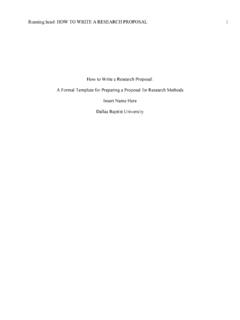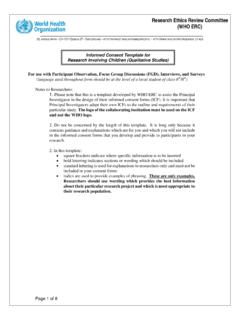Transcription of DIVA 2
1 ENGLISH. DIVA Diagnostic interview for ADHD. in adults (DIVA). D iagnostisch I nterview V oor A DHD bij volwassenen diagnostic interview for ADHD Kooij, MD, PhD & Francken, MSc in adults 2010, DIVA Foundation, The Netherlands Colophon Introduction The Diagnostic interview for According to the DSM-IV, ascertaining the diagnosis of ADHD in adults ADHD in adults (DIVA) is a involves determining the presence of ADHD symptoms during both childhood publication of the DIVA and adulthood. Foundation, The Hague, The Netherlands, August The main requirements for the diagnosis are that the onset of ADHD symp- 2010.
2 The original English toms occurred during childhood and that this was followed by a lifelong translation by Vertaalbureau persistence of the characteristic symptoms to the time of the current evalua- Boot was supported by tion. The symptoms need to be associated with significant clinical or psycho- Janssen-Cilag Back- social impairments that affect the individual in two or more life situations1. translation into Dutch by Because ADHD in adults is a lifelong condition that starts in childhood, it is Sietske Helder. Revison by necessary to evaluate the symptoms, course and level of associated impair- dr.
3 Kooij, DIVA ment in childhood, using a retrospective interview for childhood behaviours. Foundation and Prof. Philip Whenever possible the information should be gathered from the patient and Asherson, Institute of supplemented by information from informants that knew the person as a child Psychiatry, London. (usually parents or close relatives)2. Reprinted with permission The Diagnostic interview for ADHD in Adults (DIVA). from the Diagnostic and The DIVA is based on the DSM-IV criteria and is the first structured Dutch Statistical Manual of Mental interview for ADHD in adults.
4 The DIVA has been developed by Kooij Disorders, Text Revision, and Francken and is the successor of the earlier Semi-Structured Fourth Edition (Copyright interview for ADHD in adults2,3. 2000). American Psychiatric Association. In order to simplify the evaluation of each of the 18 symptom criteria for ADHD, in childhood and adulthood, the interview provides a list of concrete This publication has been and realistic examples, for both current and retrospective (childhood) behav- put together with care. iour. The examples are based on the common descriptions provided by adult However, over the course of patients in clinical practice.
5 Examples are also provided of the types of time, parts of this publication impairments that are commonly associated with the symptoms in five areas of might change. For that everyday life: work and education; relationships and family life; social con- reason, no rights may be tacts; free time and hobbies; self-confidence and self-image. derived from this publica- tion. For more information Whenever possible the DIVA should be completed with adults in the presence and future updates of the of a partner and/or family member, to enable retrospective and collateral DIVA please visit information to be ascertained at the same time.
6 The DIVA usually takes around one and a half hours to complete. The DIVA only asks about the core symptoms of ADHD required to make the DSM-IV diagnosis of ADHD, and does not ask about other co-occurring psychiatric symptoms, syndromes or disorders. However comorbidity is commonly seen in both children and adults with ADHD, in around 75% of cases. For this reason, it is important to complete a general psychiatric assessment to enquire about commonly co-occurring symptoms, syndromes and disorders. The most common mental health problems that accompany ADHD include anxiety, depression, bipolar disorder, substance abuse disor- ders and addiction, sleep problems and personality disorders, and all these should be investigated.
7 This is needed to understand the full range of symp- toms experienced by the individual with ADHD; and also for the differential diagnosis, to exclude other major psychiatric disorders as the primary cause of ADHD symptoms' in adults2. 2 DIVA Diagnostic interview for ADHD in adults Instructions for performing the DIVA. The DIVA is divided into three parts that are each applied around the age of 10-12 years of age, but have difficulty to both childhood and adulthood: for the pre-school years. n The criteria for Attention Deficit (A1). n The criteria for Hyperactivity-Impulsivity (A2) For each criterion, the researcher should make a decision n The Age of Onset and Impairment accounted for by about the presence or absence in both stages of life, ADHD symptoms taking into account the information from all the parties involved.
8 If collateral information cannot be obtained, the Start with the first set of DSM-IV criteria for attention deficit diagnosis should be based on the patient's recall alone. If (A1), followed by the second set of criteria for hyperactiv- school reports are available, these can help to give an ity/impulsivity (A2). Ask about each of the 18 criteria in idea of the symptoms that were noticed in the classroom turn. For each item take the following approach: during childhood and can be used to support the diagno- sis. Symptoms are considered to be clinically relevant if First ask about adulthood (symptoms present in the last they occurred to a more severe degree and/or more 6-months or more) and then ask about the same symptom frequently than in the peer group or if they were impairing in childhood (symptoms between the ages of 5 to 12 to the individual.)
9 Years)4-6. Read each question fully and ask the person being interviewed whether they recognise this problem Age of onset and impairment and to provide examples. Patients will often give the same The third section on Age of Onset and Impairment ac- examples as those provided in the DIVA, which can then counted for by the symptoms is an essential part of the be ticked off as present. If they do not recognise the diagnostic criteria. Find out whether the patient has always symptoms or you are not sure if their response is specific had the symptoms and, if so, whether any symptoms were to the item in question, then use the examples, asking present before 7-years of age.
10 If the symptoms did not about each example in turn. For a problem behaviour or commence till later in life, record the age of onset. symptom to be scored as present, the problem should occur more frequently or at a more severe level than is Then ask about the examples for the different situations in usual in an age and IQ matched peer group, or to be which impairment can occur, first in adulthood then in closely associated with impairments. Tick off each of the childhood. Place a tick next to the examples that the examples that are described by the patient. If alternative patient recognises and indicate whether the impairment is examples that fit the criteria are given, make a note of reported for two or more domains of functioning.











